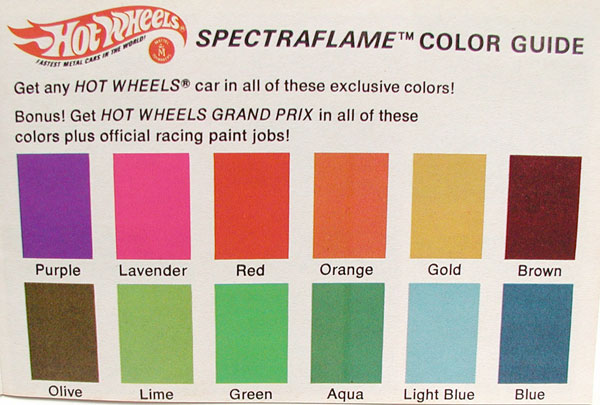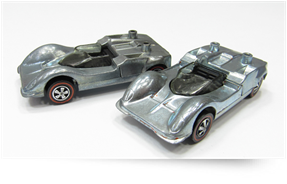SPECTRAFLAME COLORS...
Spectraflame redlines were originally listed in the 1968 catalog as being available in two colors each. When sales exploded, that quickly changed. All of the cars in 1968 have been found in at least nine colors, and for some models, as many as 16 different colors are known to exist. But exactly how many different colors were used between 1968 and 1972 is still unknown.
When the first engineering pilot samples arrived from the factory, there was one color pallet from the beginning. Mattel never officially released this color pallet to the general public, but the closest thing to an official release can be found in the 1969 Collector's Catalog.
This color listing shows 12 different colors being used, but as time would tell, it is far from accurate. Spectraflame redlines have been found in a number of different colors and shade variations that were not listed in the 1969 catalog.
Along with the original color pallet, Mattel had several experimental colors that were used in the early years of production. Mattel's color pallet changed several times during production. By 1970, new colors were being introduced and existing colors were reformulated or phased out all together. By the end of 1972, there were at least 16 distinct colors found, but to date, as many as 24 distinct colors have been documented. Of the 24 found, this does not even include shade variations.
HOT WHEELS COLORS, THE SPECTRAFLAME YEARS...
1970 Spoilers King 'Kuda
#7 has bushing wheels which is an earlier axel used by Mattel. #2 has capped wheels which came later in production.
SHADE VARIATIONS...
Shade variations are colors resulting from production issues and have become a very important part of Spectraflame redline collecting. As factories ran out of paint, different paint vendors would be used resulting in different formulations for a specific color. Shades, tones and thickness of the paint would change as vendors were changed. Sometimes it changed very little, sometimes it changed a lot. See the example:
PRODUCTION PROBLEMS...
Formulation and vendor changes were not the only cause for variations, but Mattel's own quality control issues played a factor in shade variations.
Normal production would start with the lightest color and then transition to the darker colors as production moved through the color pallet. But due to time constraints as to the production run of a casting, plants were forced to move on to the next color without properly cleaning the paint lines. By failing to completely remove the excess paint from a previous run, transition colors resulted, creating unique shades of the various colors from the main pallet.
Spectraflame & Toning
Both VWs are gold. The darker one has a completely toned casting making it a completely different variation.
CASTING QUALITY...
Aside from the painting process, the preparation of the casting itself plays a huge role in shade variations.
Spectraflame paint is a transparent paint. Since it is transparent, the base that it is being applied to must be consistent and pure. If the Zamac that was used was not properly polished or was impure, the tone and shade of the Spectraflame is greatly affected.
This is why sometimes cars have an "over-chrome" appearance. Those cars just happen to have a better plating, or a better batch of metal or had fewer imperfections.
What most collectors fail to realize is that the appearance of the paint results from what is underneath. Take toning as an example. Toning is not a flaw in the paint, but a flaw within the metal or tarnish on the metal's surface. Paint does not tone, the metal casting tones. Since the Spectraflame is transparent, such flaws cannot be hidden.
So, the condition of the Zamac can influence a color significantly resulting in a new shade or color all together. This is probably one of the reasons Mattel switched to strictly enamel paints after 1972.

Two King 'Kudas One is an early release as indicated by the bushing axels that were used; the other a later release as it has a later axel type. Both are blue, but each has an obvious shade distinction. Most likely different vendors were used to furnish the paint. The two cars above clearly demonstrate that. Obviously, one vendor's blue did not match a later vendor' blue and this would apply to the whole color pallet throughout the five years of production. Another possibility could be the formulation was changed. Still in either case, a shade variation resulted.
THE COLORS...
Below are links to the main colors found on redines from 1968-1972 as derived by collectors. Under each main color are the variations of that color. Note that the color used on Hong Kong cars varies from the paint used on U.S. cars. So when comparing shade variations one cannot compare U.S. to Hong Kong cars and vise versa. Click on an image to enlarge.
ZAMAC Castings
Unpainted Chaparral 2Gs show the variaion in the finish of the Zamac material. The closer Chap has a much brighter finish and when painted will result with a brighter Spectraflame finish.




